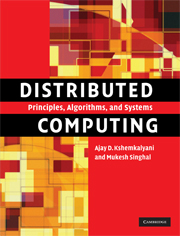Book contents
- Frontmatter
- Contents
- Preface
- 1 Introduction
- 2 A model of distributed computations
- 3 Logical time
- 4 Global state and snapshot recording algorithms
- 5 Terminology and basic algorithms
- 6 Message ordering and group communication
- 7 Termination detection
- 8 Reasoning with knowledge
- 9 Distributed mutual exclusion algorithms
- 10 Deadlock detection in distributed systems
- 11 Global predicate detection
- 12 Distributed shared memory
- 13 Checkpointing and rollback recovery
- 14 Consensus and agreement algorithms
- 15 Failure detectors
- 16 Authentication in distributed systems
- 17 Self-stabilization
- 18 Peer-to-peer computing and overlay graphs
- Index
17 - Self-stabilization
Published online by Cambridge University Press: 05 June 2012
- Frontmatter
- Contents
- Preface
- 1 Introduction
- 2 A model of distributed computations
- 3 Logical time
- 4 Global state and snapshot recording algorithms
- 5 Terminology and basic algorithms
- 6 Message ordering and group communication
- 7 Termination detection
- 8 Reasoning with knowledge
- 9 Distributed mutual exclusion algorithms
- 10 Deadlock detection in distributed systems
- 11 Global predicate detection
- 12 Distributed shared memory
- 13 Checkpointing and rollback recovery
- 14 Consensus and agreement algorithms
- 15 Failure detectors
- 16 Authentication in distributed systems
- 17 Self-stabilization
- 18 Peer-to-peer computing and overlay graphs
- Index
Summary
Introduction
The idea of self-stabilization in distributed computing was first proposed by Dijkstra in 1974. The concept of self-stabilization is that, regardless of its initial state, the system is guaranteed to converge to a legitimate state in a bounded amount of time by itself without any outside intervention. A non-self-stabilizing system may never reach a legitimate state or it may reach a legitimate state only temporarily. The main complication in designing a self-stabilizing distributed system is that nodes do not have a global memory that they can access instantaneoulsy. Each node must make decisions based on the local knowledge available to it and actions of all nodes must achieve a global ojective.
The definition of legitimate and illegitimate states depends on the particular application. Generally, all illegitimate states are defined to be those states which are not legitimate states. Dijkstra also gave an example of the concept of self-stabilization using a self-stabilizing token ring system. For any given token ring when there are multiple tokens or there is no token, then such global states are known as illegitimate states. When we consider a distributed system where a large number of systems are widely distributed and communicate with each other using message passing or shared memory approach, there is a possibility for these systems to go into an illegitimate state, for example, if a message is lost. The concept of self-stabilization can help us recover from such situations in distributed system.
Information
- Type
- Chapter
- Information
- Distributed ComputingPrinciples, Algorithms, and Systems, pp. 631 - 676Publisher: Cambridge University PressPrint publication year: 2008
